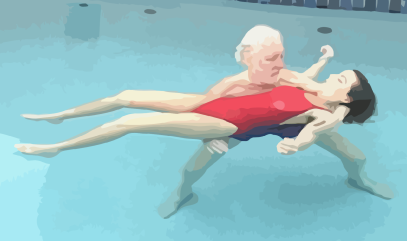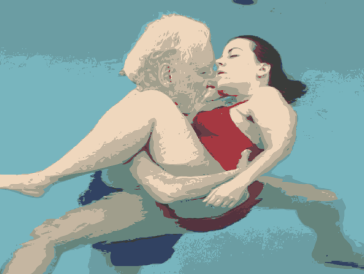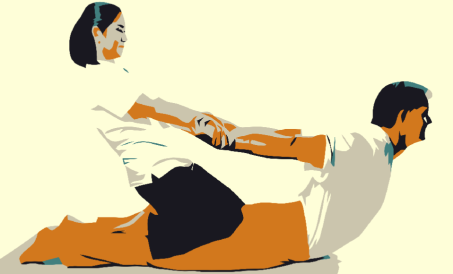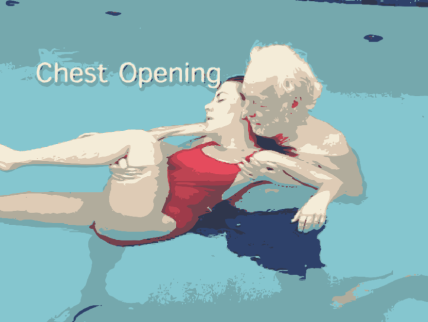
The unknown art of oppositional breathing in Watsu
1. During a Watsu session, the synchronization of the giver and receiver breathing is essential. For Harold Dull, it is a characteristic of Watsu that links the coordination of movements to the harmony of breathing (“Watsu as a Path of Meditation, Connection, Exploration and Flow”). "Unlike the other forms of Aquatic Bodywork that pull or dance someone around a pool", the constant proximity of the two bodies, which gives Watsu its nurturing dimension, allows the practitioner to easily follow the receiver's breath (“Defining Presence in Watsu”). For Harold, the only music that should rhythm a session is that of the receiver's breathing, even if it is light or discreet.
2. During the Opening of the session, the surrender to the water allows both bodies to move effortlessly to the rhythm of the breath, to rise on the inspiration, to sink on the expiration. The giver can thus establish a connection to the receiver’s breath which will rhythm the first Watsu Basic movements, Water Breath Dance, Offerings as well as Accordions.
3. The Water Breath Dance represents the most emblematic movement of Watsu, at least from the mid-1990s, when the floats began to be used. “The focus on stretching that started Watsu expanded to include a profound connection to the breath” (“What Distinguishes Watsu”). It is a movement of ascent and descent in the water engendered by the shared breathing of partner. The giver does nothing but follow the receiver’s breath.
4. The Accordion is another movement of which Harold details most precisely the breath pattern: "when you are ready to breathe out, without force, let partner's hips sink as you gradually bring your arms together. Wait until you feel your partner breathe in. With each inbreath, spread your arms to a greater openness, feeling the expansion across your chest. With each outbreath, sink the hips deeper to bring the knees closer to the chest”. Similarly, the Rotating Accordion is done with synchronized breathing. We do not bring the receiver’s knees closer to the chest when he inhales because this small violence would upset his breathing rhythm. And if at this moment the practitioner inhales, this generates a contradiction between the voluntary and muscular action of his arms and the involuntary effects of his chest opening produced by his inspiration.
5. All this is well known. What is a little less, much less, or even not known at all, is that the success of certain movements, especially in Watsu 2 sequence, requires that the giver and the receiver are breathing in opposition to each other. The habit of following the receiver’s breath is so deeply rooted in some instructors or practitioners that they persist in practicing it even in movements where it is contraindicated or even a little absurd.
6. Stretching, Openings and other Twists are done on the receiver's exhalation, that is to say when her/his muscles relax: Back Opening, Chest Opening, Twist Over… This indication is explicitly given by Harold for the Back Opening: “As partner breaths out, pull apart. Hold as he or she breathes in. Continue pulling the upper and lower apart with each outbreath.” Harold, on the other hand, says nothing about the giver’s breath when performing this move. However, it’s clear that the pulling of the hands griping the scapula and the iliac crest will be easier, fluid and sensitive if the giver inhales deeply to open his rib cage, which has the mechanical effect of moving his arms away each other. To put it another way, if the receiver must be in a state of muscular relaxation, the giver produces a muscular effort facilitated by the effects of inspiration. In addition, these movements are done by coming out of the water very slightly, which is done naturally if the practitioner is inhaling.
7. The same logic leads to practicing oppositional breathing when performing Spine Pull. If it has to be done when the recipient relaxes, that is to say exhales, it will be performed more easily if the practitioner stretches his human Crossbow while inhaling.
8. It is in the text of a Westerner on Thai massage ‒ Bob Haddad, "Breath and Body Mechanics in Nuad Boran" (1) ‒ that I’ve found the most enlightening analysis on oppositional breathing. “Oppositional breathing is when the client and therapist are breathing in opposition to each other. This type of breathing pattern is beneficial for certain movements and techniques that require strength and focus on the part of the therapist, and relaxation (openness) on the part of the client. For example, when the therapist executes Cobras (…), the receiver should exhale as she is being brought into position. The therapist, however, should inhale as he lifts her into position, because the increased oxygen to his body will give him more strength as he engages his core muscles and moves his own body.”
9. Lovers of breathing orthodoxy can be reassured: we adopt again synchronized breathing to exit Openings (Bob Haddad gives the example of the exit from an assisted Cobra). Thus, it is recommended to practice the Opening of the back over several breaths. Otherwise the practitioner only performs some choreography without the receiver feeling any openness. After a few breaths, the practitioner adapts his breathing to exhale at the same time as his receiver, which promotes the "release in the water". “It’s not as complicated as it seems, and once you practice this method of breathing, it will make your work easier and more enjoyable. Take some time to consider using oppositional breathing in your practice for certain poses and techniques. And remember to synchronize on a mutual exhale when you release or return to starting position.” (Bob Haddad)
10. The whole art of the practitioner therefore consists in knowing how to adopt, according to the movements, synchronized or oppositional breathing. With a little thought, practice and awareness it’s quite easy to identify which movements require synchronized breathing and which ones work best with oppositional breathing.
(1) In Bob Haddad, Thai Massage & Thai Healing Arts. Practice, Culture and Spirituality, Findhorn Press, 2013. In massage schools of Thailand, breathing indications are rare and sketchy.





